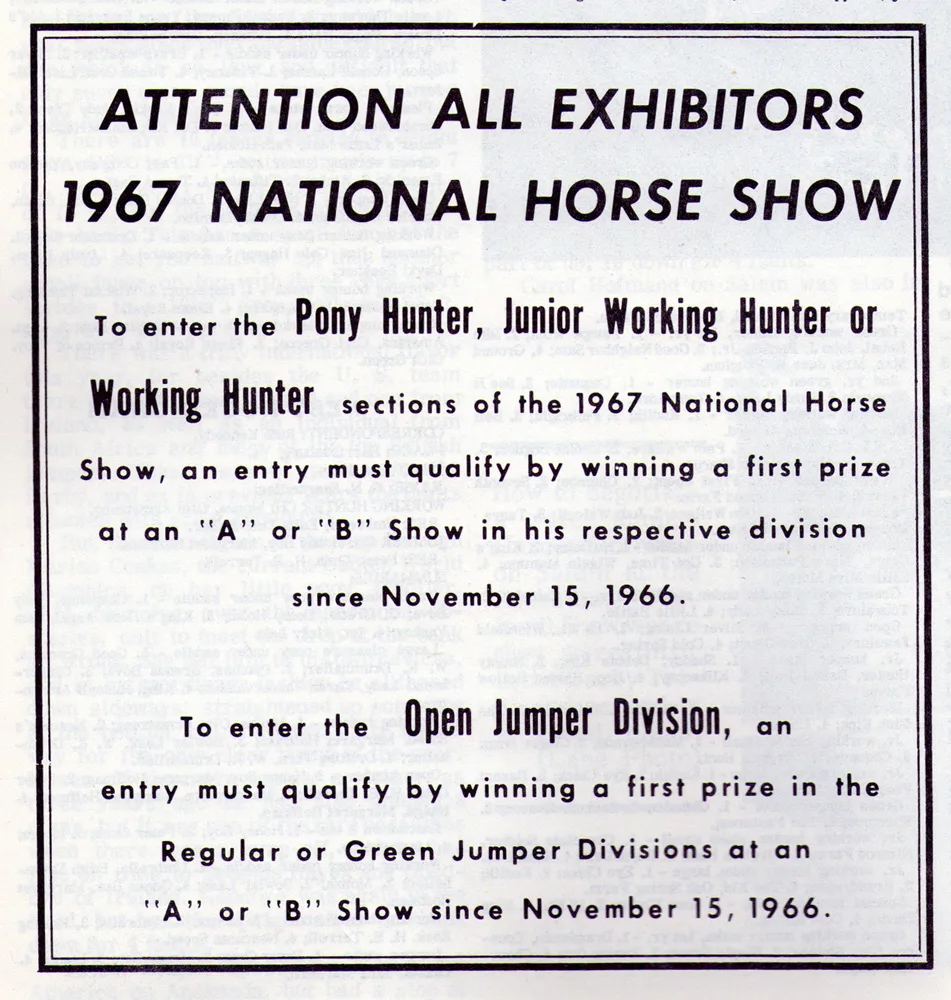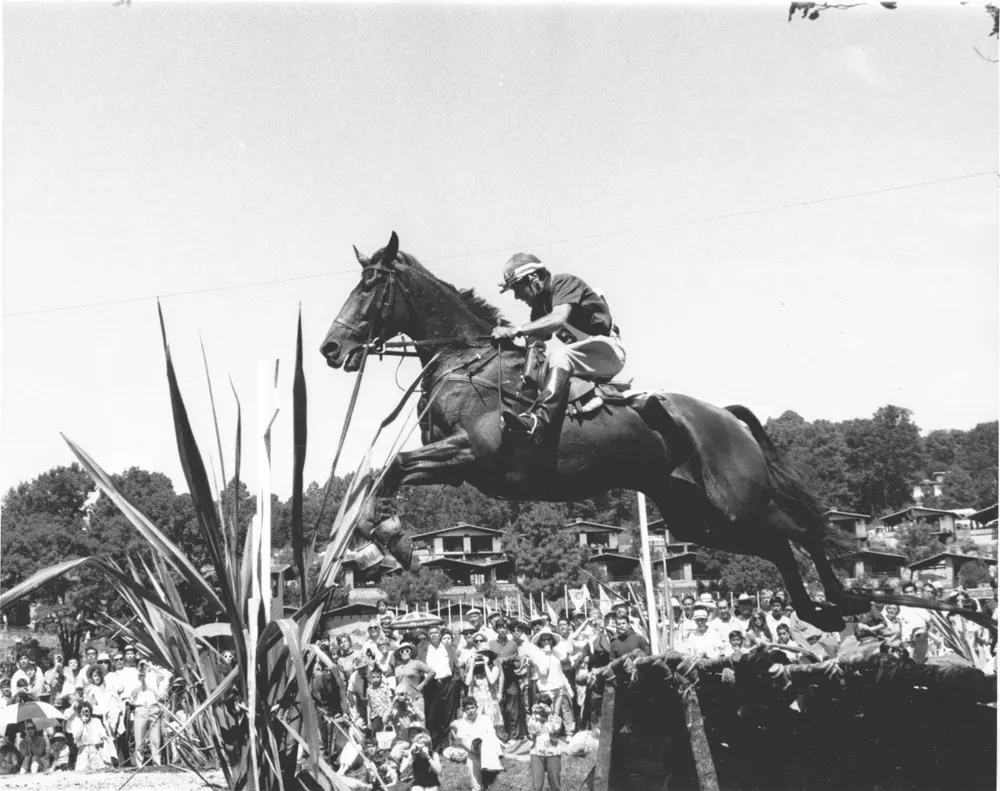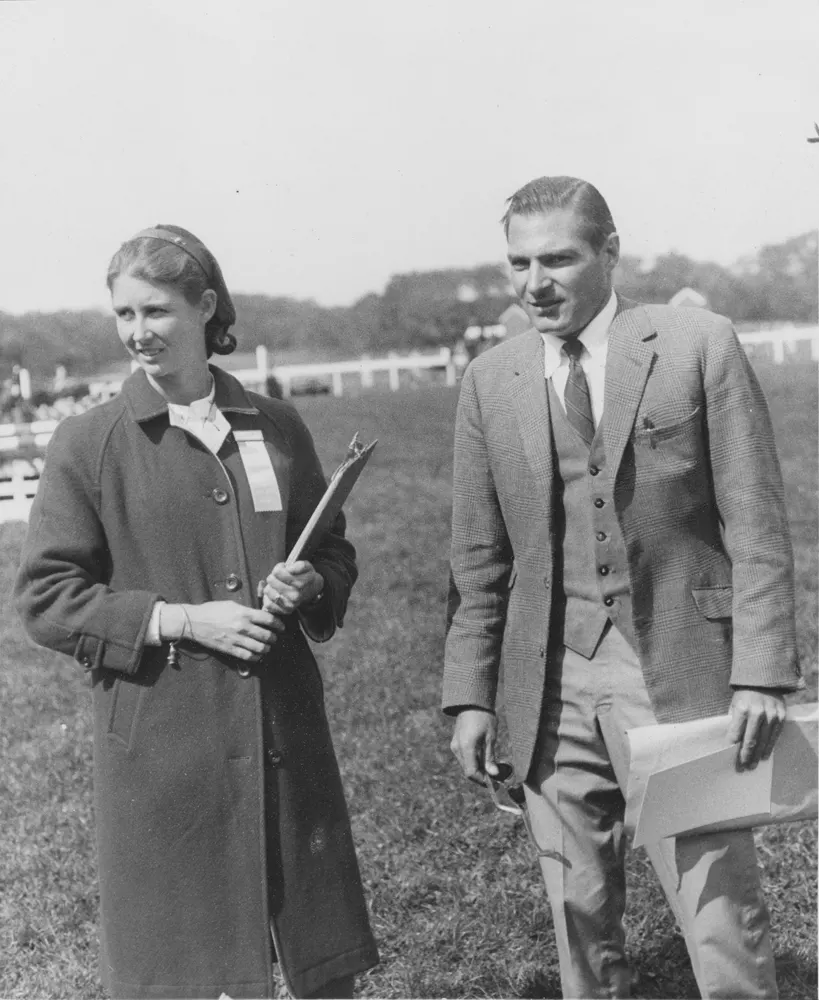The Chronicle of the Horse is celebrating its 85th birthday in 2022. For eight weeks leading up to the publication of our 85th Anniversary Issue, we’re bringing you a decade-by-decade look at the history that has filled its pages since 1937.
The decade of the 1960s was a golden era for horse sports and for the Chronicle. The ‘60s saw glamorous hunter stars like Cold Climate, Cap And Gown, and Isgilde become famous. The U.S. Equestrian Team sent jumper stars like Frank Chapot, Bill Steinkraus, Kathy Kusner and Hugh Wiley overseas to compete, and they won on the biggest stages like Aachen, Germany. Thoroughbreds reigned supreme in both the hunters and the jumpers.

Green hunters in the 1960s jumped imposing fences like this one. Bimbay and Celia Rumsey were the green working hunter champions at the 1960 Southampton Horse Show. Freudy Photo.
The Chronicle covered three Olympic Games in the 1960s—1960 in Rome, 1964 in Tokyo and 1968 in Mexico City. U.S. riders won team silver in show jumping in 1960, where a young George Morris placed fourth individually. In 1968, Bill Steinkraus earned a historic individual gold medal in Mexico City. U.S. riders took team silver in the three-day event in ’64 and ’68, with Mike Plumb taking individual bronze in ’68 and Michael Page individual bronze in ’64.
The first grand prix show jumping event was held on July 25, 1965 in Cleveland, Ohio (Mary Mairs [Chapot] won it on Tomboy). The USET began taking a more proactive approach to developing international teams when it established a training center at Gladstone, New Jersey.
In 1961, the Chronicle made a significant change—it was, in fact, the birth of The Chronicle of the Horse magazine. The Chronicle’s publisher, the G.L. Ohrstrom Estate, bought out another publication, Horse, and in a Jan. 6, 1961, issue, the merged magazine debuted. Readers first saw the iconic cover, with its swirling artwork and distinctive logo, in this issue. Editor Alexander Mackay-Smith explained the change to readers in an editorial.
By 1960, the Chronicle’s circulation had grown from 5,000 subscribers to 12,000, and in 1961, a few months after announcing the new The Chronicle of the Horse, Mackay-Smith devoted another editorial to magazine business, explaining a rise in subscription rates from $7 per year to $9. He noted that since 1948, the Chronicle had doubled its page numbers each week and covered twice as many shows in a year, expanding their coverage to racing, polo and dressage.
In the ‘60s, Thoroughbred racing was still prominent in the magazine. The first article in each issue was the legendary Raleigh Burroughs’ column about the racing scene, and the yearly stallion issue was devoted to racing Thoroughbreds.
But the other horse sports were gaining prominence. Reports on the top shows like Devon (Pennsylvania), Upperville (Virginia), and the indoor shows like the Pennsylvania National and the National Horse Show in Madison Square Garden (New York) became more and more descriptive and colorful.
Changing Times
Many writers who reported on shows for the Chronicle wrote under pen names, like “Tanbark” and “Fencepost.” But Margaret L. Smith always wrote under her own name. In a 1960 report on the Pennsylvania National, she described a battle between two Thoroughbreds—Cold Climate and Bold Minstrel—for the prestigious conformation hunter title. In the ‘60s, the conformation hunters were the stars, the best horses. And Cold Climate was just 5 at that point, having been shown in the green conformation division as a 3- and 4-year-old.
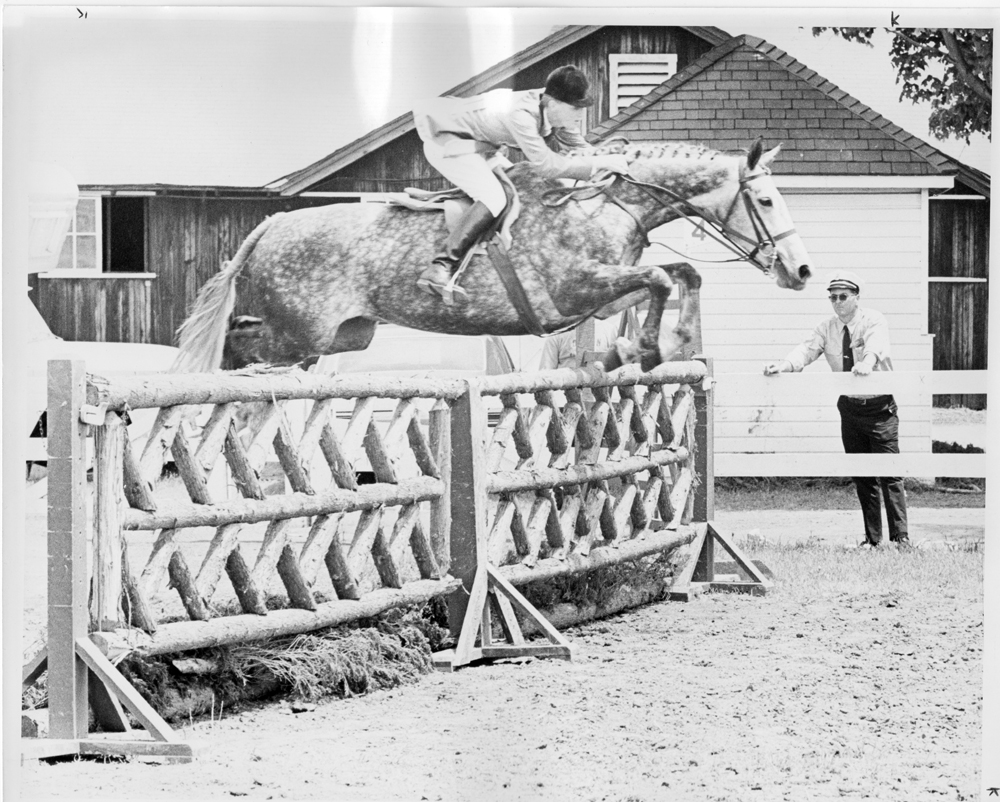
The story about the 1967 Devon Horse Show starts: “Whenever Rodney Jenkins turns up at a horse show, reporters just sit back and relax, resting assured that Rodney will give them the lead for their story. And he almost always does.” That year at Devon, Jenkins rode 16 horses and claimed three championships, including the working hunter title on Mrs. A.C. Randolph’s Sky Ghost. Budd Photo
Amateur divisions began appearing in the hunter rings. Jumpers became more popular, even at the old-school bastions of hunters. A report from the 1967 Upperville Horse Show contained this note: “Back in 1853 when Col Richard Hunter Dulaney of the 7th Virginia Cavalry inaugurated the first horse show in the sylvan, picturesque setting outside Upperville, Va., he had probably never even heard of an open jumper.
“But this year, the 114th annual show, there they were. It was a green jumper division. And some eighteen entries weaved their way in amongst the trees over the courses designed by Gen. F.F. Wing and built by Erskine Bedford and Adgar “Eggie” Mills.
“If the reaction of the crowd and the exhibitors is any yardstick, I feel sure that the 115th will see the jumpers back again.”
Epic Diaries
Some of the reporting in the Chronicle’s pages was pretty perfunctory, but Editor Alexander Mackay-Smith could be counted on for a good read. His reports on international competitions gave the reader not just the facts of the results, but also the feeling of the atmosphere, like in his report on the team show jumping competition of the 1960 Rome Olympic Games.
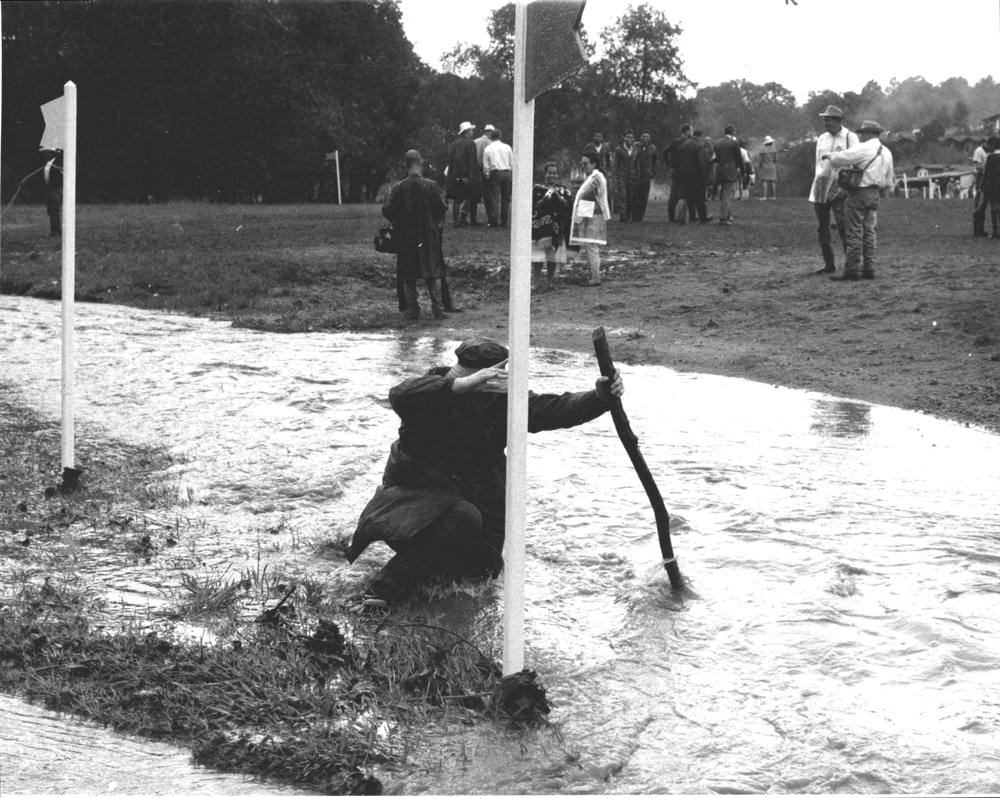
This is the infamous water jump of the 1960 Mexico City Olympic Games. The original caption reads: “The last obstacle after the cloudburst becomes a river. The revetted banks of the jump being under water, the last 15 horses had to flounder through it, fortunately without injury.” Gamecock Photo.
By the late ‘60s, Mackay-Smith had developed an unusual formula for covering international competitions. He would travel with the USET team abroad and report in the Chronicle in the form of an informal diary, describing their training and preparation for the events as well as the actual results of the day. This culminated in his coverage of the 1968 Olympic Games in Mexico. The bare-bones results of the Games were published quickly in the magazine’s In The Country section, but Mackay-Smith spread out his “Mexican Olympic Diary” Olympic coverage over months, starting in November, more than a month after the Games’ completion, and ending in January 1969. There were nine installments, covering each of the three sports.
ADVERTISEMENT
In the early ‘60s, there weren’t many advertisements in the Chronicle, and the same ads repeated for months on end. They were, however, high-end advertisers, like Cadillac and Rolls Royce. As the decade continued, more and more diverse advertisements appeared, such as feed companies and horses for sale. The first congratulatory ads for sold horses appeared. The classified ad section continued to be the definitive source for a horse or employment. The first hints of color in the Chronicle appeared in 1967, when a tint appeared in an advertisement.
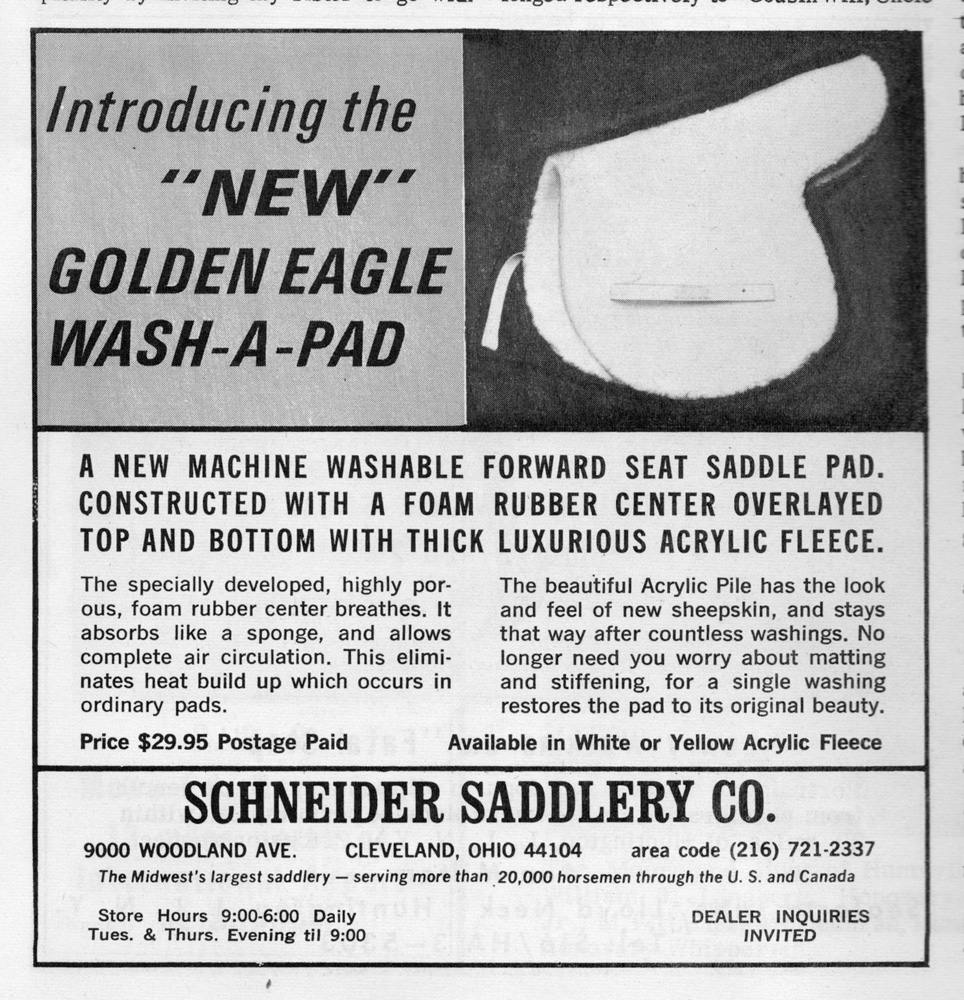
Most photos from the ’60s show riders choosing to tack up without a saddle pad, but by the late ’60s, ads for shaped pads were showing up in the magazine’s pages.
Hot-Button Issues
As always, the Chronicle could be counted on to put in print what people were talking about at the in-gate. One of the hot topics of the ‘60s was women riders. By that decade, women riders had competed at the Olympic Games in dressage and show jumping, but it was 1964 in which Lana DuPont (Wright) became the first woman to compete in the Olympic Three-Day Event. The announcement about the shift in rules appeared in a brief news item in the Feb. 8, 1963, Chronicle, stating simply: “As a result of the action of the British delegate to the FEI meeting, the FEI has decided to allow women to compete in the three day event at the 1964 Olympics in Tokyo. After that the question of female participation in this event will be further considered.”
Mackay-Smith commented on the decision in an editorial titled: “The Weaker Sex And The Olympic Three Day Event.” “Certainly this broadening of the Three-Day base will have a profound effect on the world equestrian picture,” he wrote. “Opening up the Olympic Three Day Event will undoubtedly induce many top women riders to train themselves and their horses for the try-outs to select the 1964 Teams.”
The More Things Change The More They Stay The Same
Some topics of hot debate in the Chronicle in the ‘60s are moot points now, such as a raging flurry of letters and editorials about differences in judging jumper classes between FEI rules and national rules—national classes counted “ticks,” or rubs, while international classes didn’t.
But many hot-button topics of the ‘60s sound eerily familiar. Editorials and letters to the editor abound about the use of tranquilizers in hunters.
Concern about the safety of cross-country jumps is ever-present.
The word “shamateur” isn’t just a recent invention to describe amateur-owner riders who may skirt the U.S. Equestrian Federation amateur rules. In the ‘60s, it was used to describe international riders. Mackay-Smith’s editorial calling for the inclusion of professional riders in Olympic teams was more than 10 years in advance of the rule change.
Then, as now, prominent horsemen wondered where the next generation of international stars would come from. You may recognize the author of this Letter to the Editor, published in the Oct. 14, 1960, issue.
Olympic Observation
Dear Sir:
One of my observations after watching the Olympics, namely the Prix des Nations, was “what next”?
I would be one of the first to agree that we now have one of the foremost teams in the world. I say now.
But what do we have four, or eight years from now? I can name only four or five riders who have the necessary international experience that one needs to negotiate an Olympic course, whereas Britain has anywhere from eight to ten riders who are capable. Most of them have ridden overseas at one time or another, thus gaining the necessary experience.
I can only suggest that we send a team of five or six, instead of the former four riders. These extra riders could be rotated from time to time, thus providing us with a “strong bench” as it were.
ADVERTISEMENT
Before this can be accomplished, I believe that the training methods used here in the U.S. must be improved. Many instructors are able to teach very little to their pupils, due to a lack of knowledge of theory. In short, too many people know how, and too few people know why!
To quote Lt. Col. H.D. Chamberlin—“The correct principles of equitation and horse training are in themselves simple and well defined, and easily within the comprehension of any intelligent mind.
Sincerely yours,
James C. Wofford
Say What?
While weighty topics and controversies appeared regularly, the Chronicle has many light-hearted moments. A famous horse even wrote a letter to the editor.
The Letters to the Editor section wasn’t limited to discussions of what appeared in the pages of the magazine, as it is now. Readers treated it as a way to communicate with the horse world at large, as in this letter that appeared in the Dec. 1, 1967, issue.
Moving West
Dear Sir:
We are hoping to move from our New Jersey place to the Flagstaff, Arizona, area. To do this, we would like to ask the help of your wonderful publication, without which, we assure you, life just wouldn’t be complete!
We don’t know a soul out there and thought that, perhaps, some horse people might like to get in touch with us by mail, to tell us a little bit about the area, horsewise. (Do you have a pack of hounds—we couldn’t find one in the Roster, if not, is there interest in hunting, etc.)
The Chronicle of the Horse has been a great help to us in so many ways, for so many years. We’ve learned many things from it, have been laughing tears with Raleigh Burroughs and crying tears with some of the poets, young and old. Your classifieds have helped sell some of our good hunters and we simply thank you for everything.
Sincerely,
Dinah and Jim McGowan
R.D. 1, Box 141
Califon, N.J.
And this letter, from May 24, 1968.
Phenylbutazone
Dear Sir:
I would never, never give Phenylbutazone to my horse in order to make him go sound in competition, but I’m surely going to stock it in our stable veterinary cabinet. My husband is careless and he has been stepped on while he helps me feed and water in the morning. I figure if I can shoot him full of Phenylbutazone fast enough, it will protect my ears from a lot of bad language and be of great help to him as he sprints for the train.
Read about all the decades of the Chronicle: the 1930s and 1940s | the 1950s | the 1960s | the 1970s | the 1980s | the 1990s | the 2000s










